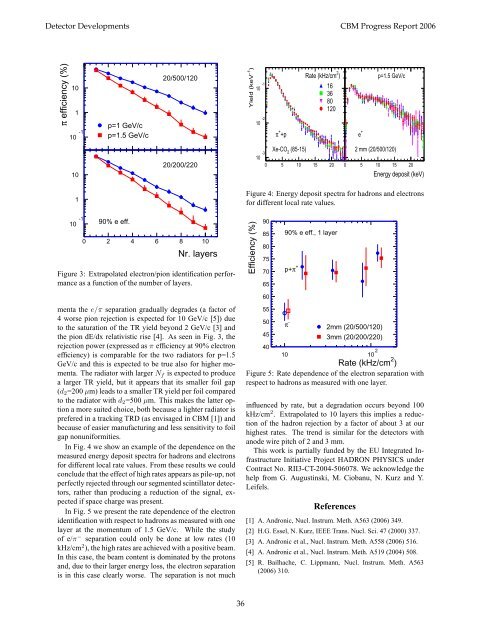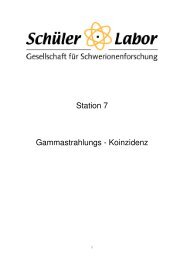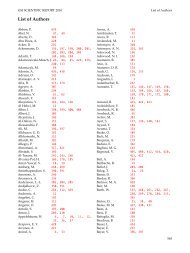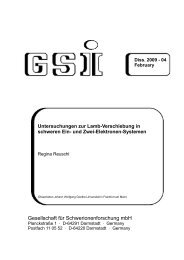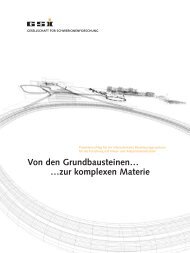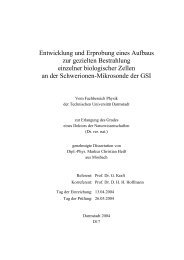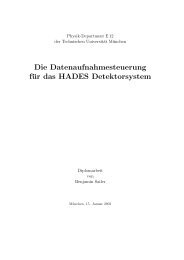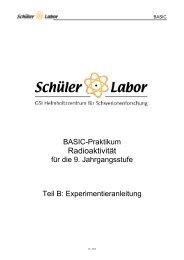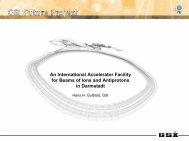CBM Progress Report 2006 - GSI
CBM Progress Report 2006 - GSI
CBM Progress Report 2006 - GSI
You also want an ePaper? Increase the reach of your titles
YUMPU automatically turns print PDFs into web optimized ePapers that Google loves.
Detector Developments <strong>CBM</strong> <strong>Progress</strong> <strong>Report</strong> <strong>2006</strong><br />
π efficiency (%)<br />
10<br />
1<br />
10 -1<br />
10<br />
1<br />
10 -1<br />
p=1 GeV/c<br />
p=1.5 GeV/c<br />
90% e eff.<br />
20/500/120<br />
20/200/220<br />
0 2 4 6 8 10<br />
Nr. layers<br />
Figure 3: Extrapolated electron/pion identification performance<br />
as a function of the number of layers.<br />
menta the e/π separation gradually degrades (a factor of<br />
4 worse pion rejection is expected for 10 GeV/c [5]) due<br />
to the saturation of the TR yield beyond 2 GeV/c [3] and<br />
the pion dE/dx relativistic rise [4]. As seen in Fig. 3, the<br />
rejection power (expressed as π efficiency at 90% electron<br />
efficiency) is comparable for the two radiators for p=1.5<br />
GeV/c and this is expected to be true also for higher momenta.<br />
The radiator with larger Nf is expected to produce<br />
a larger TR yield, but it appears that its smaller foil gap<br />
(d2=200 µm) leads to a smaller TR yield per foil compared<br />
to the radiator with d2=500 µm. This makes the latter option<br />
a more suited choice, both because a lighter radiator is<br />
prefered in a tracking TRD (as envisaged in <strong>CBM</strong> [1]) and<br />
because of easier manufacturing and less sensitivity to foil<br />
gap nonuniformities.<br />
In Fig. 4 we show an example of the dependence on the<br />
measured energy deposit spectra for hadrons and electrons<br />
for different local rate values. From these results we could<br />
conclude that the effect of high rates appears as pile-up, not<br />
perfectly rejected through our segmented scintillator detectors,<br />
rather than producing a reduction of the signal, expected<br />
if space charge was present.<br />
In Fig. 5 we present the rate dependence of the electron<br />
identification with respect to hadrons as measured with one<br />
layer at the momentum of 1.5 GeV/c. While the study<br />
of e/π − separation could only be done at low rates (10<br />
kHz/cm 2 ), the high rates are achieved with a positive beam.<br />
In this case, the beam content is dominated by the protons<br />
and, due to their larger energy loss, the electron separation<br />
is in this case clearly worse. The separation is not much<br />
36<br />
Yield (keV -1 )<br />
10 -1<br />
10 -2<br />
10 -3<br />
π + +p<br />
Xe-CO 2 (85-15)<br />
Rate (kHz/cm 2 )<br />
16<br />
36<br />
80<br />
120<br />
0 5 10 15 20<br />
e +<br />
p=1.5 GeV/c<br />
2 mm (20/500/120)<br />
0 5 10 15 20<br />
Energy deposit (keV)<br />
Figure 4: Energy deposit spectra for hadrons and electrons<br />
for different local rate values.<br />
Efficiency (%)<br />
90<br />
85<br />
80<br />
75<br />
70<br />
65<br />
60<br />
55<br />
50<br />
45<br />
40<br />
90% e eff., 1 layer<br />
p+π +<br />
π -<br />
2mm (20/500/120)<br />
3mm (20/200/220)<br />
10 10 2<br />
Rate (kHz/cm 2 )<br />
Figure 5: Rate dependence of the electron separation with<br />
respect to hadrons as measured with one layer.<br />
influenced by rate, but a degradation occurs beyond 100<br />
kHz/cm 2 . Extrapolated to 10 layers this implies a reduction<br />
of the hadron rejection by a factor of about 3 at our<br />
highest rates. The trend is similar for the detectors with<br />
anode wire pitch of 2 and 3 mm.<br />
This work is partially funded by the EU Integrated Infrastructure<br />
Initiative Project HADRON PHYSICS under<br />
Contract No. RII3-CT-2004-506078. We acknowledge the<br />
help from G. Augustinski, M. Ciobanu, N. Kurz and Y.<br />
Leifels.<br />
References<br />
[1] A. Andronic, Nucl. Instrum. Meth. A563 (<strong>2006</strong>) 349.<br />
[2] H.G. Essel, N. Kurz, IEEE Trans. Nucl. Sci. 47 (2000) 337.<br />
[3] A. Andronic et al., Nucl. Instrum. Meth. A558 (<strong>2006</strong>) 516.<br />
[4] A. Andronic et al., Nucl. Instrum. Meth. A519 (2004) 508.<br />
[5] R. Bailhache, C. Lippmann, Nucl. Instrum. Meth. A563<br />
(<strong>2006</strong>) 310.


